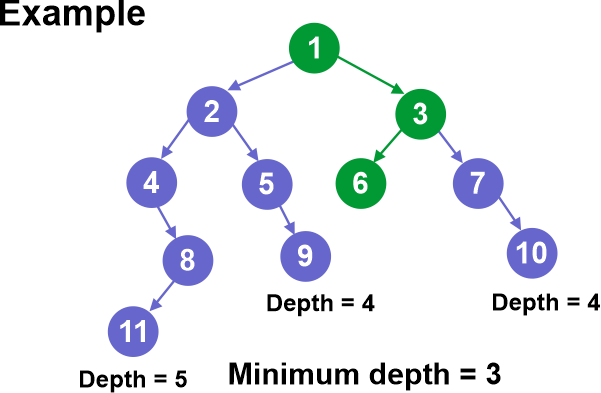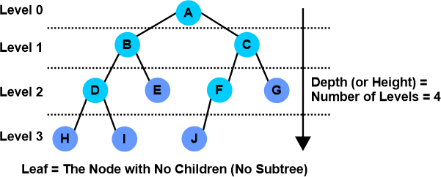Minimum Depth Binary Tree
The depth of the binary tree is the number of levels of tree where the nodes elements are present on tree data structure. The minimum depth of a binary tree is the shortest distance from the root node to a leaf node. The minimum depth is also known as the minimum height of the tree. The minimum depth of a binary tree is an important property of the tree because it can affect the performance of certain tree traversal algorithms, such as breadth-first search. A tree with a small minimum depth will have a larger minimum depth than a tree with a large minimum depth, which means that it will take longer to reach the leaf nodes in the tree. This can have an impact on the time complexity of the algorithm. The minimum depth of a binary tree is also important because it can be used to determine the balance of the tree. A tree with a small minimum depth may be unbalanced, with most of the nodes concentrated at the top of the tree. On the other hand, a tree with a large minimum depth may be more balanced, with nodes distributed more evenly throughout the tree.
The minimum depth of a binary tree is defined as the shortest distance from the root node to a leaf node, where a leaf node is defined as a node that has no children. In other words, it is the length of the path from the root node to the nearest leaf node. This can be computed using a breadth-first search or a depth-first search algorithm, which visits the nodes of the tree level by level or node by node, respectively. It has various applications in computer science, such as determining the balance of a tree and providing a way to optimize tree-based algorithms by pruning branches that do not lead to any useful information. In general, a balanced binary tree is one where the minimum depth and the maximum depth differ by at most 1, which ensures that the tree is not skewed to one side and can be searched efficiently.
The minimum depth of a binary tree is equal to the number of edges in the shortest path from the root to a leaf node. The minimum depth of a binary tree is also equal to the number of nodes in the shortest path from the root to a leaf node, minus one. This is because the minimum depth counts the number of edges, and each edge connects two nodes, so the minimum depth is equal to the (number of nodes- 1)
For example, in the following binary tree the minimum depth is 2, because the shortest path to a leaf node is through the nodes with values 3 and 4:
1
/ \
2 3
/ \
4 5
In a binary tree with only one node (the root), the minimum depth is 1. In an empty binary tree (a tree with no nodes), the minimum depth is 0.
It is possible to calculate the minimum depth of a binary tree using a depth-first search or a breadth-first search. In a depth-first search, we traverse the tree by exploring as far as possible down each branch before backtracking. In a breadth-first search, we traverse the tree by visiting all the nodes at a given depth before moving on to the nodes at the next depth.

Figure: Minimum depth of Binary tree
1
/ \
2 3
/ \
4 5
Another example of the minimum depth of the binary tree is as in above structure as the minimum depth of this binary tree is 2. The shortest path from the root node (1) to a leaf node (4 or 5) is 2, which includes the nodes 1, 2, and either 4 or 5.
How to find Minimum Depth in Binary Tree
To find the minimum depth, we can traverse the tree using a breadth-first search or a depth-first search algorithm and keep track of the current depth. We start at the root node with a depth of 1 and then visit the children of the current node. Whenever we reach a leaf node, we compare its depth with the current minimum depth and update it if it is smaller.

Figure: View of minimum depth of Binary Tree
Overall, the ideal minimum depth for a binary tree will depend on the specific use case and the requirements of the application. It may be necessary to balance the trade-off between the time complexity of the algorithm and the space complexity of the tree in order to find the optimal solution. A tree with a large minimum depth may be more balanced, with nodes distributed more evenly throughout the tree. This can make it faster to reach the leaf nodes, which can improve the performance of the algorithm.
There are a few properties of the minimum depth of a binary tree that are, the minimum depth of a binary tree with n nodes is at most log (n), where log is the base 2 logarithm. This is because in a perfectly balanced binary tree, the minimum depth will be log(n), since the tree will have log(n) levels and each level will have 2^level node.